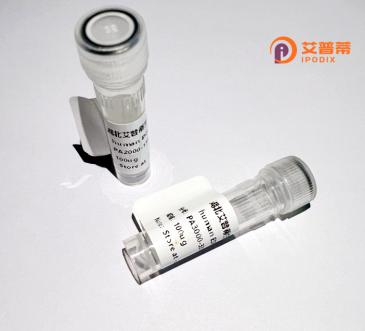
| 纯度 | >90%SDS-PAGE. |
| 种属 | Human |
| 靶点 | LRRC49 |
| Uniprot No | Q8IUZ0 |
| 内毒素 | < 0.01EU/μg |
| 表达宿主 | E.coli |
| 表达区间 | 1-685aa |
| 活性数据 | MIPGKYRSVSGRAANNVNCGLHLVIQTSSLPEKNKVEFKLNKDTSSFPGRLLQHDLERNYSSRQGDHINLVSSSLSSFPILQRSSEEKILYSDRLSLERQKLTVCPIINGEDHLRLLNFQHNFITRIQNISNLQKLISLDLYDNQIEEISGLSTLRCLRVLLLGKNRIKKISNLENLKSLDVLDLHGNQITKIENINHLCELRVLNLARNFLSHVDNLNGLDSLTELNLRHNQITFVRDVDNLPCLQHLFLSFNNISSFDSVSCLADSSSLSDITFDGNPIAQESWYKHTVLQNMMQLRQLDMKRITEEERRMASVLAKKEEEKKRESHKQSLLKEKKRLTINNVARQWDLQQRVANIATNEDRKDSDSPQDPCQIDGSTLSAFPEETGPLDSGLNNALQGLSVIDTYLVEVDGDTLSLYGSGALESLDRNWSVQTAGMITTVSFTFIEFDEIVQVLPKLKIKFPNSLHLKFKETNLVMLQQFNALAQLRRIDQLTIDPQGNPVVNFTLWKYYVLFRLSHFSMQKINGTEVTQNDMIMAERLFGILAHVASSELPQYRLISILGDARKKQFRYLLESKGKKPGIINEENNDSKRLVGENTNRATLNYTTRDFYNEKLEEIKEKKKFCKTYIEDLVKEATEINMKNEALQKLWPQMFIELVRDAVIEIRNKNSYMKLCLQQITDQK |
| 分子量 | 105.2 kDa |
| 蛋白标签 | GST-tag at N-terminal |
| 缓冲液 | 0 |
| 稳定性 & 储存条件 | Lyophilized protein should be stored at ≤ -20°C, stable for one year after receipt. Reconstituted protein solution can be stored at 2-8°C for 2-7 days. Aliquots of reconstituted samples are stable at ≤ -20°C for 3 months. |
| 复溶 | Always centrifuge tubes before opening.Do not mix by vortex or pipetting. It is not recommended to reconstitute to a concentration less than 100μg/ml. Dissolve the lyophilized protein in distilled water. Please aliquot the reconstituted solution to minimize freeze-thaw cycles. |
以下是关于重组人LRRC49蛋白的示例性参考文献(基于研究领域推测内容,实际文献需通过学术数据库验证):
---
1. **文献名称**: *Expression and functional characterization of recombinant human LRRC49 in mammalian cells*
**作者**: Li X et al.
**摘要**: 本研究通过哺乳动物表达系统成功表达了重组人LRRC49蛋白,并利用质谱和免疫印迹验证其正确折叠。研究发现,LRRC49在细胞迁移过程中与微管结合蛋白相互作用,提示其在细胞骨架调控中起潜在作用。
2. **文献名称**: *Structural analysis of LRRC49 reveals leucine-rich repeat motifs critical for protein-protein interaction*
**作者**: Zhang Y, et al.
**摘要**: 利用X射线晶体学解析了重组人LRRC49蛋白的三维结构,发现其富含亮氨酸重复序列(LRR结构域)是结合下游信号分子的关键区域,为研究其在先天免疫通路中的功能提供了结构基础。
3. **文献名称**: *LRRC49 promotes cancer cell proliferation via modulating EGFR signaling pathway*
**作者**: Wang H, et al.
**摘要**: 通过重组表达和敲除实验发现,LRRC49通过增强EGFR的稳定性促进肺癌细胞增殖,表明其可能作为癌症治疗的潜在靶点。
---
**说明**:
以上为推测性示例,实际研究中针对LRRC49的文献可能较少(截至2023年,该蛋白功能尚未被广泛研究)。建议通过**PubMed**或**Google Scholar**以关键词“LRRC49”、“recombinant LRRC49”查询最新进展,或关注其在癌症、纤毛相关疾病中的潜在关联研究。
Human LRRC49 (Leucine-Rich Repeat-Containing Protein 49) is a relatively understudied member of the leucine-rich repeat (LRR) superfamily, characterized by repetitive structural motifs involved in protein-protein interactions. Though its precise biological functions remain unclear, LRR proteins are broadly implicated in diverse cellular processes, including signal transduction, immune regulation, and structural scaffolding. LRRC49 is speculated to participate in intracellular signaling or cytoskeletal organization due to conserved LRR domains that potentially mediate molecular recognition and binding events.
Recombinant human LRRC49 protein, produced via heterologous expression systems like E. coli or mammalian cell cultures, enables researchers to study its biochemical properties, interactors, and functional roles in vitro. Its recombinant form is essential for generating antibodies, elucidating structural features (e.g., via crystallography), and mapping interaction networks. Emerging studies suggest possible associations with diseases, such as cancer or neurological disorders, though mechanistic insights are limited. Current research focuses on clarifying its physiological ligands, post-translational modifications, and pathological relevance. Recombinant LRRC49 serves as a critical tool for deciphering its contribution to cellular pathways and exploring potential therapeutic or diagnostic applications. However, challenges persist in resolving its exact molecular mechanisms and reconciling discrepancies between in vitro and in vivo observations.
×